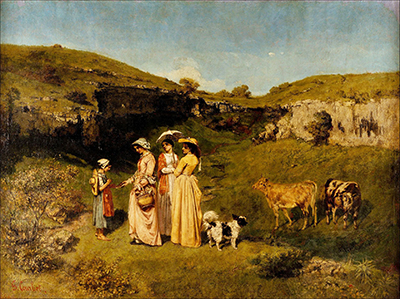Young Ladies of the Village, or Les Demoiselles de Village, to use its original French name, was put together by Gustave Courbet in 1851-1852 and captures two of the artist's favourite passions - women and the countryside.
This is another Courbet painting now owned by the Metropolitan Museum of Art, New York, USA. They have almost an embarrassment of riches, with around 1,700 European paintings amongst their huge collection. They also have a large number of American paintings, as you might expect. Together, it is a superb introduction to art history from a western view, though they also have other items from right across the rest of the world. Some of the notable contributors to their European paintings collection include Eugène Delacroix, J.M.W Turner, Francisco Goya, Jacques-Louis David and Henri Rousseau.
The key focus of this painting is three sisters out together enjoying the countryside and coming across a young girl whom they offer some food. They appear to be of a higher standing than this girl, suggesting perhaps that they have felt pity for her situation and are keen to help her out. They have a small dog alongside them plus some animals placed in the background. Courbet features the poor within his work frequently, something that had not been done often before. It also upset a number of art critics, though he continued to devote much of his attention to those with whom he felt the greatest connection.
The painting was placed on display at the Paris Salon in 1852 under the elongated title of 'The Village Maids give alms to a cowherd in a valley near Ornans'. Whilst unpopular with some, it was immediately purchased by a private buyer. It would then exchange hands many times before finally ending up at the Metropolitan Museum of Art in 1940. Their own collection is a mixture of donations and private purchases.




